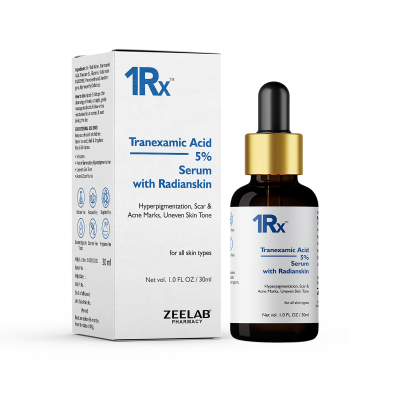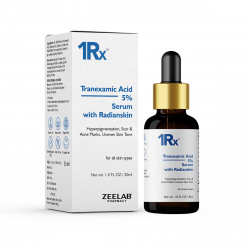Tranexamic Acid for Melasma | Best Treatment for Pigmentation


Tranexamic acid (TXA) is commonly used to treat melasma, a skin condition that causes dark patches on the face. It’s especially common in women and can be triggered by hormones or sun exposure. TXA is a gentle, effective option that helps reduce pigmentation without irritating the skin.
What is Tranexamic Acid?
Tranexamic acid is a synthetic form of lysine, an amino acid that plays a role in various bodily functions. Initially developed to reduce excessive bleeding by stabilizing blood clots, it has now become a popular ingredient in skincare, especially for treating pigmentation problems.
Its skin-lightening effect was first observed in patients taking TXA for bleeding disorders, who reported reduced pigmentation. TXA can suppress melanin production, leading to its adoption in treating conditions like melasma.
How Does Tranexamic Acid Work for Melasma?
Melasma develops when melanocytes (pigment-producing cells) are triggered by factors like UV rays, hormones, or inflammation. TXA helps reduce pigmentation by inhibiting plasmin, an enzyme that plays a role in inflammation and stimulates melanin production.
By blocking this pathway, TXA reduces the signals that lead to excess melanin formation, thereby preventing and fading dark spots without the harsh effects of bleaching agents.
Benefits of Using Tranexamic Acid for Melasma
- Gentle yet effective: It lightens pigmentation gradually without causing skin peeling or irritation.
- Suitable for all skin types: Especially beneficial for sensitive skin and deeper skin tones prone to pigmentation.
- Improves overall complexion: With regular use, it evens out skin tone and boosts brightness.
- Pairs well with other ingredients: Works synergistically with actives like niacinamide, kojic acid, and vitamin C for faster results.
Also read - Tranexamic Acid for Pigmentation
Available Forms of Tranexamic Acid
| Form | Details |
|---|---|
| Topical TXA (Creams and Serums) | Commonly available in 2–5% concentrations, applied directly to affected areas. Suitable for mild to moderate melasma and daily use. |
| Oral Tranexamic Acid | Prescribed in low doses by dermatologists for stubborn or deep melasma. Results usually seen within 8–12 weeks of supervised use. |
| Injectables (Mesotherapy) | In-clinic treatment where TXA is injected directly into the skin. Provides quicker effects, often used with other therapies. |
Note: Oral or injectable TXA should only be used under a doctor’s supervision.
Best Tranexamic Acid Serum for Melasma

If you’re struggling with dark patches on your face caused by melasma, 1RX Tranexamic Acid 5% Serum is a gentle and effective solution. It helps reduce pigmentation, brightens your skin, and gives you an even tone without irritation. Perfect for daily use, this serum suits all skin types and works well under sunscreen or moisturizer. Regular use can visibly fade stubborn dark spots.
How to Use Tranexamic Acid Safely
- Start with low frequency: Begin using topical TXA 2–3 times a week, increasing gradually as tolerated.
- Use at night: Apply after cleansing and before moisturizing for best absorption.
- Never skip sunscreen: While TXA doesn’t make skin photosensitive, sun exposure can worsen melasma. Use broad-spectrum SPF daily.
- Avoid layering with harsh actives: Using strong exfoliants like AHAs, BHAs, or retinoids simultaneously may cause irritation.
Myths and Facts About Tranexamic Acid
| Myth | Fact |
|---|---|
| TXA is a skin bleach. | It does not bleach; it regulates melanin production. |
| You’ll see results overnight. | Improvements are gradual—usually after 4 to 8 weeks. |
| TXA is unsafe for long-term use. | Topical TXA is generally safe when used correctly. |
| Natural remedies work better. | Natural ingredients may help, but TXA works faster and more effectively. |
Natural Supportive Remedies for Melasma
- Aloe vera gel: Soothes inflamed skin and supports healing.
- Licorice extract: A natural brightener that slows melanin production.
- Green tea extract: Offers antioxidant protection.
- Healthy diet: Antioxidant-rich foods (berries, leafy greens, omega-3s) promote skin clarity and resilience.
Who Should Be Cautious with TXA?
- Pregnant or breastfeeding women (especially with oral forms)
- Individuals with a history of blood-clotting disorders
- Anyone with known allergies to TXA
A patch test is always recommended before starting any new skincare ingredient.
When Will You See Results?
With topical tranexamic acid, patience is key. Most people start noticing visible improvements after 6 to 12 weeks of regular use. Using TXA along with regular sun protection and a consistent skincare routine greatly improves results.
Conclusion
Melasma can be persistent, but with consistent care and the right treatment strategy, it is manageable. Tranexamic acid has proven to be a safe, effective, and dermatologist-recommended option for reducing pigmentation and restoring skin confidence. Whether you’re just starting your melasma journey or exploring new treatment options, TXA is worth considering. As always, consult a skincare professional to find the approach best suited to your skin’s needs.
Frequently Asked Questions (FAQs)
Q. Can tranexamic acid cure melasma?
A. No, it doesn’t cure melasma, but it helps manage and fade pigmentation effectively with regular use.
Q. Is tranexamic acid safe for every skin type?
A. Yes, most skin types, even those that are sensitive or prone to acne, can safely use topical tranexamic acid.
Q. How long does tranexamic acid take to work on melasma?
A. Visible results usually appear within 6–12 weeks of consistent use. Results may vary depending on the severity of melasma and the form of TXA used (topical, oral, or injectable).
Q. Can I use tranexamic acid during pregnancy?
A. Topical tranexamic acid is usually considered safer than oral forms during pregnancy, but first consult your doctor before use.
Tranexamic Acid 5% Serum With Radiant sk...

















 Added!
Added!